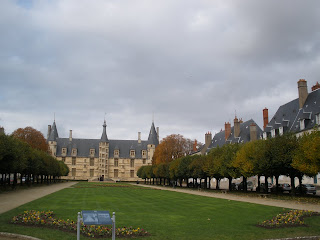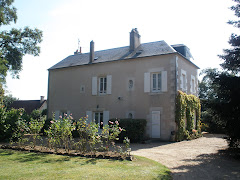



The origins of the city that is now called Nevers are a bit mysterious, if only because a serious archeological investigation has yet to be accomplished in the region. Many people think that the contemporary city of Nevers is located on the site of a Roman town called Noviodunum Aeduorum, and another Roman called Neverinum provides an attractive historical trace. The names of both of these towns provide an obvious link with the contemporary names Nevers and la Nièvre, so the fact that some Roman ruins found in this general region of the Loire river tends to close the link. In any case, Nevers is a town with a rich Common Era history, to which the two symbols of power in the center of town-- the religious power of Cathedral and the temporal power of the Palais Ducal (Ducal Palace)-- give witness. Nevers has certainly known municipal difficulties in the last one hundred years. After the second world war, many neighborhoods were ravaged. Although the cathedral was repaired, it seems that even now there are buildings that suffered from attacks. Furthermore, in the last 50 years, suburban sprawl to the exterior of town has decreased the aesthetic value of the greater communal area. Yet all of that aside, in the second half of the second millenium of the Common Era, Nevers was quite a hub of activity, and the Ducal Palace was the headquaters of an industrious population.
The Palais Ducal distinguishes itself from the rest of the city by its remarkably clean and well-groomed appearance, which offsets even more its distinctive château-esque architecture. It sits at the edge of the central square, the Place Carnot and looks out over two large open spaces with a vista that extends to the Loire. In terms of building materials, the tan brick that composes the palais is also distinctive-- the rest of Nevers is fairly uniformly built of a pale stone or cement-covered stone, depending on the period of construction. Some fanatics for the city claim that the palais ducal in Nevers is the first of the famous "Châteaux de la Loire" the name given to the disparate group of renaissance-era private residences for various royal families that all inhabited the same river on which Nevers is set- La Loire. Although personally I find that appelation (naming) a bit prétentieux (pompous), it is a fancy private residence, the earliest part of whose construction dates to the 15th century. So château or not, it is on the Loire and it is the oldest one there. Also, as it is the only architecture in Nevers that is remotely noble, it dominates the city as a kind of de-facto château.
The Palais Ducal is the pride of Nevers, and the city honors it well. In 1840 it was named a Monument Historique and thus is part of the very first group of monuments preserved under France's highest classification of honor and government protection . Yet, as every part of the contemporary presentation of the palais proves, Nevers is far frompassively contented with its little monument and its sedentary history. For example, the current city blazon (insignia/crest) is a modern sketch of the recognizable towers from the palais. Furthermore, to the side of the palais is a modern tourist office with a small glass pyramid that recalls a renouvellement of a certain Parisian palace (Le Louvre and its pyramid, anyone?). And on the inside of this pyramid is an exhibit that presents the history of Nevers, from earliest times (those Roman remnants I mentioned at the beginning of the post) to the ducal era through to the contemporary period, in which Nevers is known for its Formula One race track (Magny Cours) and faïence (painted porcelin). Above all, since the restauration of the palais in the 1980s, the building is often used for official meetings and events in its many large conference and ball rooms.
If you're ever in Nevers, don't forget to visit the Palais Ducal. When I arrived in the city and was giving my first classes to my high schoolers, they mockingly said I should go visit the palais if I was looking for something to do. But it's true, it's a monument rich in a unique history. A forthcoming blog post will explain a bit more of the familial heritage and the multi-stage construction of the building. The principle families that ruled as the Dukes of Nevers were the Clamcey, Clèves, and Gonzaga, the last of which, you might imagine, had the most profound influence on the ultimately renaissance style of the southerly façade, the side that looks out onto the aforementioned places with the spectacular vista. Climbing the grand spiral staircases and looking out onto the city that shrinks into the landscape of river and hills, one understands and appreciates what it may have been like to mistreat and renounce the paysans et villageois (peasants and villagers). But I don't renounce you villageois, even if the places where we live are far and largely overpowered by the impressive natural barriers that separate us.
Plein de bisous, mes amours !



No comments:
Post a Comment